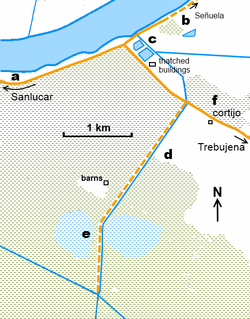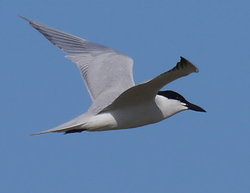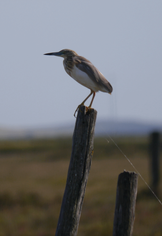
 Gull-billed tern
Gull-billed tern  Squacco Heron at (e)
Squacco Heron at (e) Definitely a place worth exploring!
| Birding Cadiz Province |
|
|
The marshes along Guadalquivir are about an hour's drive from my base in Alcala so, with so many closer sites to visit, it's not a site I get to as often as I'd like. Hence it's somewhere that I feel I could know better. Also, arriving from the direction of Sanlucar, as I often do, it's very easy to find yourself spending so much time birding familiar sites like Bonanza, Laguna de Tarelo and Algaida pines/salinas that you have little time for exploration. Even if you approach from Trebujena via Jerez, it's difficult to avoid spending too much time watching Mesas de Asta marshes en route. Worse, both routes pass perilously close to IKEA and other shops that threaten to distract your non-birding companion. So you again find yourself with less time than you expect.  Arriving from Sanlucar, even if you manage to escape from the Bonanza and Algaida, there's still plenty to distract you as you drive along the south bank of the Guadalquivir (a). The embanked road certainly allows good views across Trebujena marshes to the south whilst to the north pools between the road and the river can attract large numbers of Spoonbills, Flamingos, waders and ducks. After a while the metalled road swings away from the river although if brave, or perhaps foolhardy, you can continue along the track beside the river (b) all the way to Seňuela and ultimately to Brazo del Este. Last time I tried, the track degenerated into a badly rutted mess and I found myself forced to risk plunging into puddles of unknown depths to make progress. In fact progress was so slow that it would have been quicker to take the longer route via Trebujena and Lebrija. the drive along the Gudalquivir is certainly a pleasant one and the chapel at La Senuela with its twenty plus White Stork nests is a picturesque sight. The pools as you turn towards Trebujena (c) are worth a quick look too; nothing too special, perhaps, but often close views of stilts and various herons. Far too many times at this point as I headed off towards Trebujena, I had a good coffee in the village more in mind that more birding. Even so I confess that I'm somewhat puzzled as to why it took me quite so long to explore the track (d) that runs across marshes from near the large cortijo on the Trebujena road. As I've already observed I tend to get to the area late in the day with less time to explore and, more importantly, when I fear I'm trespassing too much on my wife's good will. I'd also tended to assume it was a camino particular (private road). Certainly, the recent appearance of a sign suggesting it was a public road helped my resolve to check it out as did seeing others parked along it and foraging along the verges. Whatever the reason, it wasn't until spring 2013 that I headed off the metalled road and along this track.  Gull-billed tern Gull-billed tern The track, obviously, gives a different angle on the vast open marshes to the right although without the greater elevation enjoyed from the road along the Guadalquivir (perhaps another reason for my sluggish exploration). However, it certainly allows you to feel you're getting a closer view of the marshes. I've not driven the track in late summer when the marshes are often barren and dry, but in spring, particularly after a wet winter, the place is transformed. Larks, usually Crested or Short-toed, flip busily across the road as Spanish Yellow Wagtails watch from the fence. Further off a good mix of raptors – both Black and Red Kites, Marsh and Montagu's Harriers, Booted Eagles and Kestrel (Common & Lesser) – share the skies with swooping Pratincoles. Below White Storks dot the marsh, but look out too for passing Black Stork or even late Cranes that sometimes rest here The ditch on the right of the track is regularly patrolled by hunting Whiskered or Gull-billed Tern giving you great opportunities for photography particularly since you can pull over without worrying about traffic – there isn't any!  Squacco Heron at (e) Squacco Heron at (e) After a couple of kilometres further along the track swings to the left and soon thereafter you reach an area which, when I first visited in 2013 was flooded with two large, but shallow pools either side of the track (e). The deep ditches here held several Squacco and Night Herons which obligingly perched on fence posts as we passed. The banks here were a blaze of yellow, purple and white flowers. The wetter marshes concealed Black-winged Stilt, Greenshanks and a handful of smaller waders. A week later the marshes had dried out considerably and what had been water was now glutinous mud. But this mud was covered with hundreds of Dunlins and a few Little Stint and the odd Curlew Sandpiper. Returning to the main road it's always worth checking the rough grazing just across the road (f) which often has Golden Plover in winter and Pratincoles in the summer. Definitely a place worth exploring!
0 Comments
Leave a Reply. |
About me ...Hi I'm John Cantelo. I've been birding seriously since the 1960s when I met up with some like minded folks (all of us are still birding!) at Taunton's School in Southampton. I have lived in Kent , where I taught History and Sociology, since the late 1970s. In that time I've served on the committees of both my local RSPB group and the county ornithological society (KOS). I have also worked as a part-time field teacher for the RSPB at Dungeness. Having retired I now spend as much time as possible in Alcala de los Gazules in SW Spain. When I'm not birding I edit books for the Crossbill Guides series. CategoriesArchives
May 2023
|